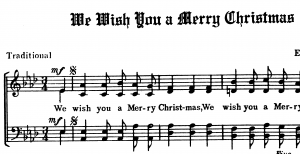Here’s an interesting experiment about human information processing, featuring me, myself and some Christmas songs.
Every Christmas season, I pull out a little book of Christmas songs and play some of them on the piano. Because I play those songs only once a year, and then only a few times, I don’t remember much about how to play them from one year to the next. So the first time I try in a new season, chances are that most of the information needed to make my fingers go where they need to go comes from the printed sheet through the visual cortex in real time.
Then, after I play them a few times (sometimes as few as once), short-term memory kicks in, and I don’t have to read every note. I can still play it and get it about equally right (or wrong …)
 Where this gets interesting is for fast pieces. For example, the one on the right. It’s arranged for four voices, and unlike some other arrangements, you can’t quite “fill in the pattern” if you can’t keep up with doing what’s actually written on paper. So it’s a good test case.
Where this gets interesting is for fast pieces. For example, the one on the right. It’s arranged for four voices, and unlike some other arrangements, you can’t quite “fill in the pattern” if you can’t keep up with doing what’s actually written on paper. So it’s a good test case.
It turns out that on the first try, I can play this piece only at about half of the speed that I’m able to play it after some “practice”.
But what does this practice consist of? I’m not growing any additional muscle in a few minutes, or any other magical powers. The only thing that’s different is that I now have the piece (or parts of it) in short-term memory.
Which clearly proves that accessing memories is much faster than accessing information through the visual cortex, even if such information is provided just in time right in front of my eyes.
A back-of-the-envelope calculation: At 180 beats per minute for this piece, the eighths in the piece are at 6Hz. Times four voices. And shall we say … 3-4 bits per note for the pitch, and maybe 2 for the duration? (that makes 8-16 possibilities for pitch, approximately an octave; and 4 possibilities for the duration.) So the relevant data stream is about 100-150 bits per second. My memory retrieval works at that speed and probably at a higher speed, too, but my visual cortext does not. It can do perhaps half as much, if I’m lucky.
(Obviously image processing in the visual cortext has much higher data rates; I’m comparing the net output of the visual processing for the information contained in the images)
I wonder whether anybody has ever done a systematic study comparing these kinds of data rates. Sight-reading sheet music might actually be a rather interesting test case because it is digital, it has a fairly compact notation that many people are familiar with, and a well-identified clock pulse. This, if anything, explains quite well why practice makes perfect, and why memorization — essential part of much training in many disciplines — might be so important.